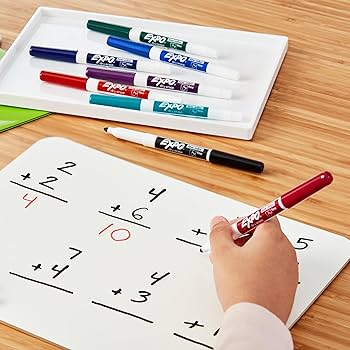Copic Markers Review
Discover the reasons why artists, illustrators, and colorists worldwide adore Copic Markers.
Copic Markers Review
You may have heard a lot of praise about Copics. Among markers, they are highly regarded as the best by artists and illustrators. They gained immense popularity during the adult coloring trend, to the point where they were often sold out. However, their price may have shocked you. It is understandable that you would want to research and determine if Copics are worth the investment. This page is created to assist you in understanding the various types best paint markers, why they are renowned, and help you decide if they are suitable for your creative workflow.
As someone who is both an artist and an author of coloring books (which have sold more than 3.9 million copies), I have had extensive experience with coloring and illustrating using various brands of markers. For over 10 years, I have been using Copic Sketch Markers on a daily basis, making me a true fan of these markers – I even own all 358 colors! In the following paragraphs, I will share the knowledge and insights I have gained from using these markers.
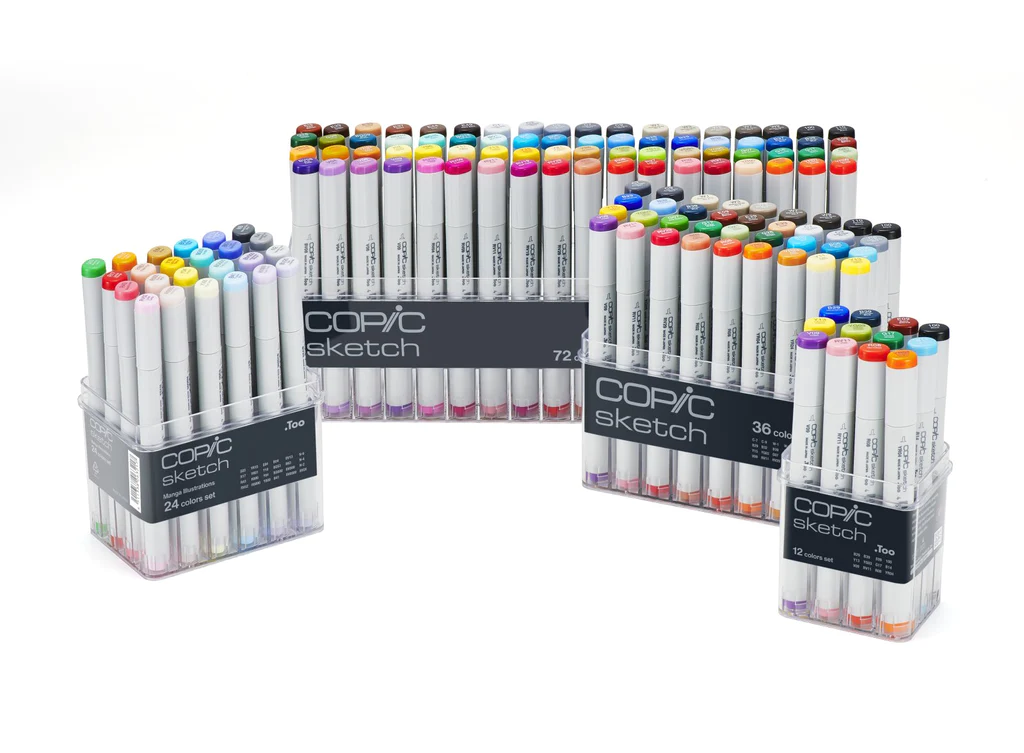
What are Copic Markers?
Copic Markers are markers of excellent quality that artists highly admire for their ability to smoothly apply and offer a vast selection of vibrant colors. These markers have two sides, each with a nib, and are filled with top-notch alcohol-based ink that is low in odor and safe to use. Artists can layer and blend Copics without experiencing streaking, and the artwork created with these markers will be long-lasting. Overall, Copics are fantastic tools for artistic expression.
Copic Markers are a durable alternative compared to inexpensive markers that are usually thrown away once the ink runs out. These markers are specifically designed to withstand time as they can be refilled and have replaceable nibs when they get worn out.
Copics, which were initially introduced in Japan in 1987 for manga artists, have expanded their range of marker styles and colors over time. This has attracted the attention of various artists including fashion illustrators, graphic designers, coloring enthusiasts, and even fine artists like myself, who have switched from traditional media to coloring with markers.
One of the reasons why Copics are priced higher than other brands is because they prioritize high-quality products. Before leaving the factory, each marker undergoes rigorous testing to ensure both quality and color consistency. Additionally, Copic diligently maintains ink consistency across batches, providing customers with certainty and confidence when purchasing new refill bottles or markers.
Copic Classic vs. Sketch vs. Ciao
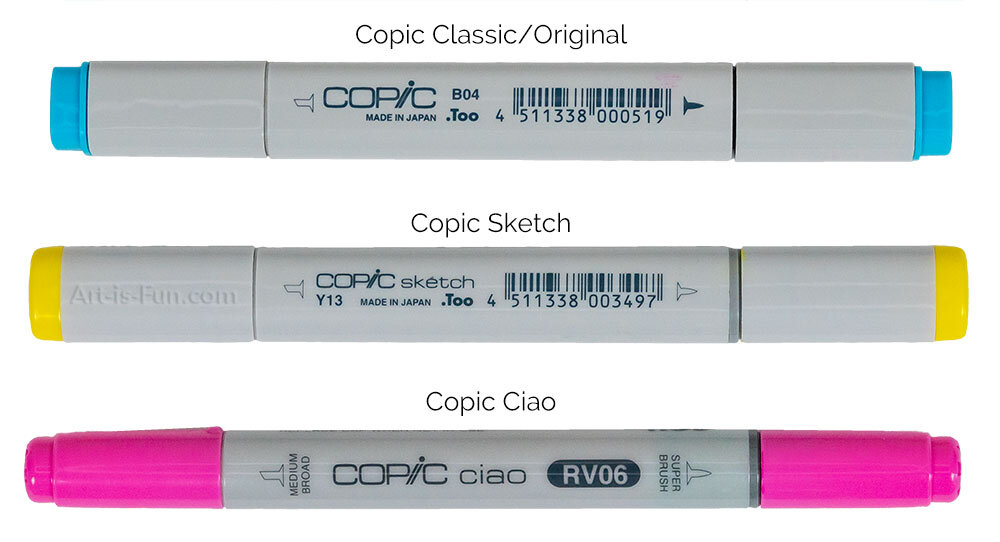
Copic offers three options for markers, which are displayed above: Copic Classic (also known as Copic Original), Copic Sketch, and Copic Ciao.
Before discussing the distinctions among these marker types, let’s first address their shared characteristics.
All of them can be refilled and use the same high-quality ink made from alcohol. Each marker has replaceable nibs that can be swapped out when they get worn out. They are all double-ended, but the type of nib on each end differ depending on the marker. The details are provided below.
Moving on to the primary distinctions, the factors that differentiate the three categories of Copic markers are their different nib shapes, sizes and shapes of the barrels, range of colors, and price.
Besides the 3 kinds of markers mentioned, Copic also provides a few other related products that I won’t be discussing in this article, but I believe they are worth mentioning. They have Multiliner pens with a limited color selection, primarily designed for precision drawing, line art, ink illustrations, or any task that demands accuracy. Copic previously had Wide Markers available in 36 colors, which were commonly used for quickly applying a large amount of color. Although they have been discontinued, you can still purchase the empty Wide Marker and fill it with your preferred ink. Furthermore, Copic offers an airbrush system that can be used with their Classic and Sketch markers, but not with the Ciao markers.
Copic Classic/Original

The Copic Classic Markers, also known as Copic Original, have two benefits compared to other markers: they contain more ink and offer a wide variety of 9 nib options. With a larger ink capacity in their square barrel, they do not require frequent refilling. Although they come with the chisel and bullet tips initially, you have the option to choose from 7 more tip shapes. However, these additional tips must be bought separately and it would be inconvenient to constantly switch between them.
The Classic markers and Sketch markers have the same price, but the Classics have a smaller range of colors with 214 compared to the 358 colors of the Sketch markers. The main problem I have with the Classics is their tips, which are the chisel and bullet shapes. These tips are not as flexible or versatile as the brush tip that will be discussed further. Even though there is a brush tip option for the Classics, it wouldn’t make financial sense to purchase an additional tip for every marker.
Check Price Copic Classic Markers
Copic Sketch

Out of all the markers available, Copic Sketch Markers are the most popular and my personal favorite. One of the main reasons why they are so popular is because of their extensive range of colors – a staggering 358 colors! No other marker even comes close to offering such a wide variety. In addition to the chisel tip, Sketch markers also feature a brush tip, which is incredibly versatile and useful. Unlike the Copic Classic Markers, you can purchase a bullet tip separately for the Sketch, but there are no other nib options available (only the chisel, brush, and bullet). Another reason why I prefer the Sketch markers is because of their oval barrel shape, which I find to be more comfortable compared to the square Classic or round Ciao markers.
The Sketch markers are pricier than the Ciao markers, which we will discuss next. However, if cost is not an issue for you, these Sketch markers offer the perfect blend of Copic’s top qualities.
Check Price Copic Sketch Markers
Copic Ciao

The Copic Ciao markers were created as a cheaper option to the Sketch and Classic markers. They are sometimes targeted towards beginners, teenagers, and kids, but they still possess all the essential features of Copic markers such as refillability, replaceable nibs, and the use of high-quality ink.
They are more affordable due to their limited color options (although they still offer an impressive selection of 180 colors!) and contain less ink (which means more frequent refilling is required). If you are purchasing markers for children, Ciao markers are perfect as their lids have small holes for ventilation, preventing choking hazards. The only downside I have noticed with Ciao markers is that their circular shape allows them to easily roll on your desk.
Check Price Copic Ciao Markers
Tip/Nib Shapes
Choosing the right Copic Marker for you largely depends on the tip shape that you prefer.
Please be aware that Copic has their own terms for describing the shape of their marker tips, but on this page, I have used more general terms (chisel, brush, and bullet) to make it easier for comparison with other brands. The specific terms used by Copic for their tips are listed below so that you are aware of them when you are buying their markers.
Brush tip

I absolutely love the brush tip on Copic markers, which they call the Super Brush nib. It is incredibly versatile and my favorite feature. When I use a light touch, I can create thin strokes with the very end of the tip. By holding the marker at an angle, I can use the flatter side of the brush tip to make thick strokes that can fill in large areas. Similar to a paintbrush, I can also create strokes with varying widths, going from thin to thick depending on how I hold and apply the marker to the paper. I often create entire artworks using just the brush tip on the marker because I enjoy it so much. Because of this, I highly recommend favoring Sketch and Ciao markers, both of which have brush tips, and not using the Original markers, which have chisel and bullet tips.
Chisel tip

The chisel tip, also known as the Broad nib, is commonly found in various marker brands. It allows you to use different sides of the chisel to create strokes with varying widths. While it is more versatile than the bullet tip, I personally find the brush tip more useful. I seldom use the chisel tip, but depending on your illustration style, it may be more suitable for you. It’s worth experimenting with them as you might end up preferring the chisel tip more than I do! All three marker types are equipped with chisel tips. However, it’s important to note that the chisel tip on the Original markers is slightly larger than the chisel tip on the Ciao and Sketch markers. Therefore, if you’re replacing the broad nib or medium broad nib, make sure to double-check and get the correct size nib.
Bullet tip

The Fine nib, also known as the bullet tip in Copic markers, is primarily designed for creating thinner strokes rather than applying a lot of color. This type of tip is only found in the Original markers, which also have a chisel tip on the other end. However, you can purchase bullet tips separately for the Sketch markers if you wish to use them alongside the brush tip. In my experience, the bullet tip cannot produce strokes that are thinner than the brush tip, so I don’t use it very often. Nevertheless, the bullet tip is useful for achieving a consistent and relatively narrow line width. If you need to depict extremely small details, I would suggest trying out true fine tip pens such as Copic Multiliner Pens, Staedtler Triplus Fineliners, or Sakura Pigma Micron Pens.
Replacing Tips
If the tips of your markers become worn, you have the option to purchase replacement tips. However, it is not a concern you need to immediately worry about, as it usually takes a considerable amount of time and usage to wear out a Copic marker tip. In fact, many of my Copics have lasted for several years without requiring a tip replacement. I only needed to replace the tips of my most frequently used favorite colors.
Taking out a tip is a straightforward process: just use tweezers to grasp it and pull it out. After that, insert the new tip in a similar way. While it is a simple task, there is a possibility of it being messy, and the tips are not meant to be frequently changed. Therefore, it is best to find a few preferred tips and stick with them rather than randomly swapping different tips.
As mentioned earlier, the Copic Original Markers offer the highest level of customization as you have the option to choose from 9 different tip shapes. However, it is important to note that additional tips need to be purchased separately as they are not included with the marker.
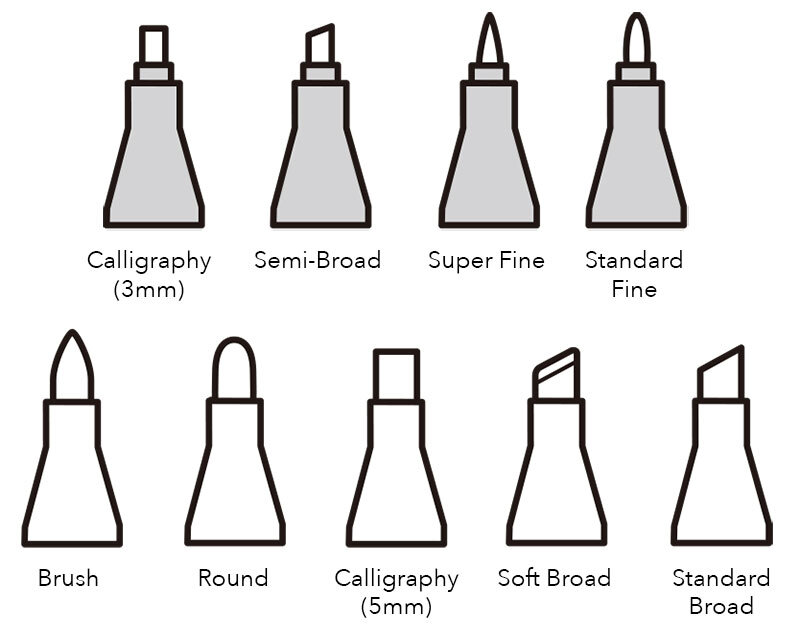
Color range
Copic surpasses all other marker brands with its extensive range of colors, boasting a whopping 358 options. The variety of colors offered allows for easy blending and seamless transitions, providing endless possibilities. However, for the average person, 358 colors may be excessive. As someone who owns all 358 Copic Sketch Markers, there are still many colors that I seldom use. Even Ciao, with its 180 colors, provides more than enough options. Consequently, the number of colors should not be the determining factor in your decision.
It should be noted that the colors of Copic markers remain consistent across different styles. This means that if you purchase the color RV06 in the Ciao marker, it will be identical to the color of the same name in the Sketch or Classic markers.
If you have a strong interest in a variety of colors, you can expand your collection even more by buying empty Copic markers (only for Sketch and Classic types) and filling them with personalized color combinations.
If you need to refill your markers, you have the option to purchase ink bottles in all 358 colors. At present, each bottle costs approximately $5-6. With 12ml of ink per bottle, you can fill a Ciao marker around 8.5 times, a Sketch marker about 6.6 times, and a Classic marker approximately 4.8 times. This means you get a substantial amount of ink for a significantly lower cost compared to constantly buying new markers.
Copic Color Charts
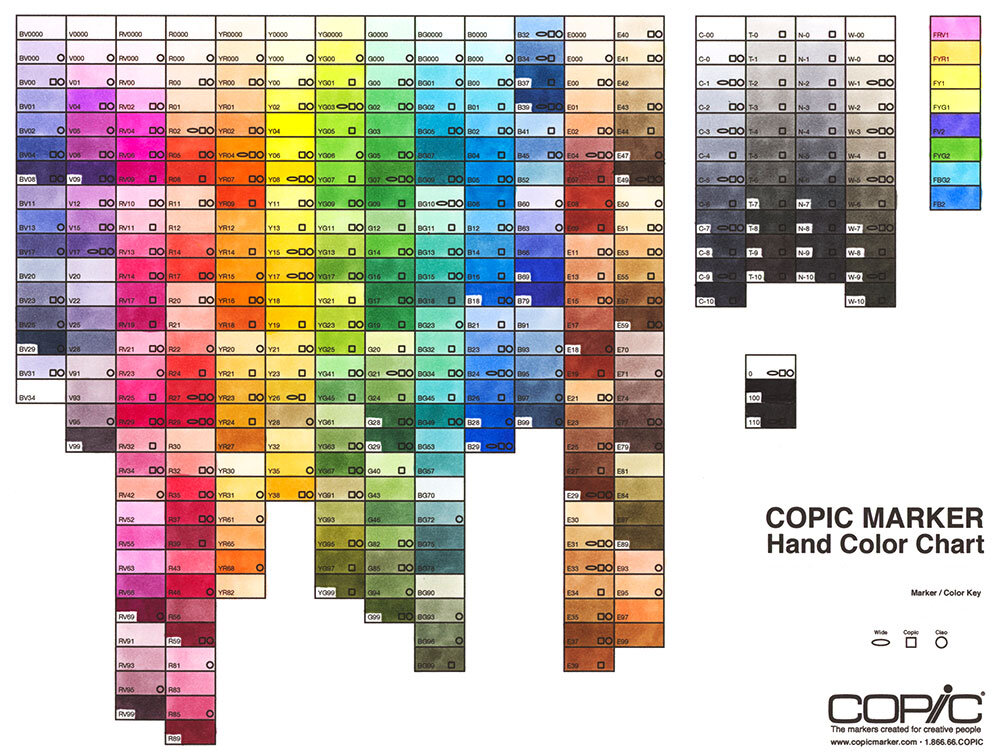
If you begin collecting colors, it is crucial to make a color chart that you can refer to. Copic has provided a template for this purpose, and you can see my finished chart below. Additionally, Copic offers a smartphone app for iOS and Android that assists in organizing your color collection. They also provide Copic Color Swatch Cards which can be filled in.
Custom Copic Color Chart
I have created a personalized color chart for Copic markers in my comprehensive guide on utilizing alcohol markers. This chart categorizes colors based on their actual appearance rather than their assigned numbers or families.
I have found my personalized Copic color chart to be extremely useful in selecting colors to blend, as it organizes similar shades together. This convenient arrangement greatly simplifies the process of identifying potential blending combinations at first glance.
Lightfastness
Lightfastness is the measure of a color’s capacity to withstand fading. For numerous artists, purchasing lightfast materials is crucial as they desire their artwork to endure for as long as possible. However, a disadvantage of markers, including Copics, is that their color comes from dyes, which are less resistant to fading compared to the pigments in things like paint, pastels, and certain pencils. Therefore, it is important to be mindful that any artwork made with Copic Markers will gradually fade, especially if exposed to daily light and humidity.
Permanent markers can also lose color over time. When discussing markers, the term “permanent” typically pertains to alcohol or solvent-based markers that cannot be erased once they have dried. These markers are essentially resistant to water, unlike water-based markers that can be revived with water even after drying.
While I display a few of my marker artworks in my house, the majority of my finished artworks are stored in archival boxes. These boxes have proven to be very effective at preserving the colors, as even after many years, there has been minimal fading. If you plan on displaying your artwork, you can consider using a product like Golden Archival Spray Varnish to protect it. However, it is highly recommended to test the varnish first on a draft or scrap drawing, as it has the potential to change the colors or, in worst-case scenarios, damage the artwork.
However, for numerous artists, including myself, the level of creative freedom that comes with using Copic Markers is more important than any worries about how long the artwork will last. Additionally, in today’s digital era, the duration of artwork is not as crucial since you can easily scan your work at a high resolution and showcase it online or have it printed.

Using Copic Markers
If you’re interested in detailed guidance from a professional artist, I recommend checking out my comprehensive video course. It spans over 11 hours and covers Copic blending techniques and other alcohol marker-related topics. However, if you’re just getting started, here are a few tips for you.
Due to the alcohol base of Copics, colors can be applied smoothly without noticeable streaks. However, it is important to work quickly as the ink dries rapidly. Once dried, adding more color will darken the existing color instead of seamlessly blending with it. Additionally, unlike water-based markers that can be re-activated with water, dried Copics remain permanent.
Here is a comparison of how color is applied using Copics and a water-based marker. The circles are 3 inches in size and are drawn on cardstock. Although alcohol markers do not create streaks, there may be slight differences in color saturation. Some areas might appear slightly lighter or darker than others. Personally, I like these subtle variations as they give the artwork a more natural and organic look, which has more character than a plain and uniform block of color.
Copics have excellent blending capabilities due to their wide range of colors. Blending is achieved by applying a wet layer of a color on top of and next to an existing color. I demonstrate this technique in my Ultimate Guide to Using Alcohol Markers. However, it’s important to note that Copic markers don’t blend as effectively on heavy, absorbent paper such as watercolor paper. For artworks that require lots of blending, I suggest using marker paper.
Copic offers a colorless blender that is filled solely with solvent. Although its name suggests it is used for blending colors, it actually serves other purposes. The colorless blender can be utilized to enhance highlights, textures, or patterns by removing ink from the paper. Additionally, it is helpful for fixing mistakes, which is personally why I most frequently use it. Moreover, the colorless blender assists in smoothly transitioning from a color to white.
Marker paper is the preferred option, but cardstock can also be suitable for using Copics. Personally, I highly recommend Neenah Exact Index 110lb Cardstock (available on Amazon) as it is my go-to choice for printing my printable coloring pages.
Being aware that, except for marker papers, alcohol-based markers usually seep through other types of paper, it is advisable to place an extra sheet of paper underneath the one you are coloring on in order to absorb the extra ink. To obtain further information, take a look at the guide titled Tips for Using Alcohol Markers in Coloring Books.
The inks from Copic also possess transparency, allowing you to overlay colors and produce various gradients, tones, and fading effects.
When it comes to comparing Copics with other markers, there are many factors to consider. Some artists may prefer water-based markers, especially if they have experience with watercolor paint, because of the way they blend and the ability to use washes. You can learn more about different marker types and brands in my Markers buying guide.
Price
I understand if you’re feeling enthusiastic about purchasing Copic Markers, but you may be taken aback by the price – and I totally understand! I won’t provide exact prices as they can vary, but typically, Copic Sketch and Classic markers range from $6 to $8 each, while Ciao markers range from $4 to $5.50 each. Buying a set can lower the overall cost, but for most people, Copics still require a considerable investment.
It is important to remember that Copic Markers are still relatively inexpensive compared to other art mediums such as painting. Painting requires costly paints, a variety of brushes, and additional accessories like a palette, paint mediums, and an easel. The supports for painting, such as canvas, can also be pricey. On the other hand, starting art with markers only requires a few colors and decent paper. That’s all! Furthermore, markers are mess-free and can be used anywhere, which is an added advantage.
Before I provide my recommendations, I want to mention that Copics, as well as other markers, can be purchased individually. So, there’s no need to feel obligated to immediately buy a whole Copic Marker Set if you’re unsure whether they’re right for you. Instead, try purchasing a few colors and testing them out. The great thing about markers is that you can mix and match different types and brands. Personally, I often combine Copics with colored pencils, gel pens, and paint pens! Therefore, you can start with just a few Copic Markers and use them alongside the markers you already own, only buying more as necessary.
My recommendations
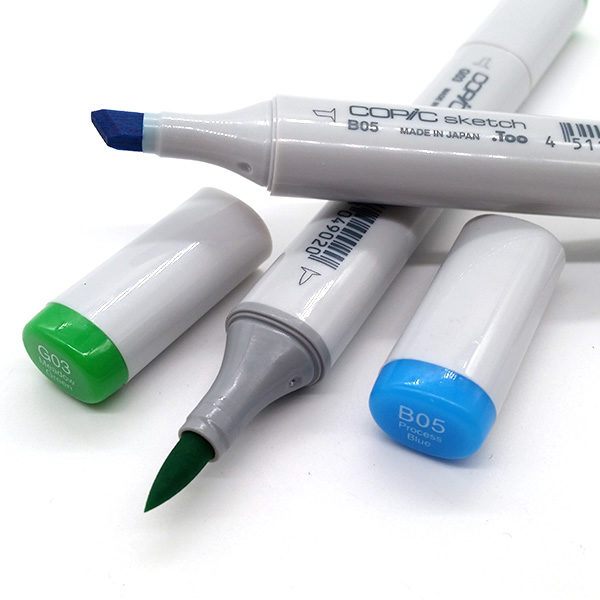
For artists and serious hobbyists
If cost is not a concern, Copic Sketch Markers are the optimal option. You receive the highest quality brush nib and it is advantageous to have a wide range of colors available. By buying a Copic Marker set, you can reduce the overall cost.
If you are passionate about art and find the Sketch markers to be too expensive, consider purchasing the Ciao markers instead. They offer the same great qualities as the Sketch markers, with the only difference being a smaller color selection. However, even with 180 colors available, the Ciao markers are still impressive and surpass what many other brands offer. Additionally, if you end up buying all the Ciao markers and desire more colors, you can always start purchasing the Sketch markers.
For those on a budget
If you are unable to afford Copics but still desire them, I suggest trying Blick Studio Brush Markers. These markers are comparable to Copic Sketch Markers in terms of quality, being refillable and having replaceable nibs. However, they are less expensive than the Ciao markers. While their range of colors is smaller with only 144 colors plus a blender, it is still sufficient for most individuals. These markers function well alongside Copics, allowing you to expand your collection in the future by purchasing some Ciao or Sketch markers.
If you haven’t used alcohol markers before and you want to try them out without spending too much, I recommend the double-ended Ohuhu Markers and Arrtx Markers. These brands may not have refill options or the wide range of colors that Copics offer, but they are much more affordable. I have personally enjoyed using both brands and you can find more information and examples of artwork I created with them in my detailed reviews.
Copic Colors
People often inquire about my preferred Copic colors and which ones they should acquire to begin their own collection. If the ultimate aim is to eventually possess all 358 Copic colors, I strongly advise purchasing a set, regardless of your budget, as it provides a better value compared to buying individual colors. Occasionally, individuals inquire about a particular recommended set, but since I initially bought my Copics individually, I cannot provide a personal recommendation. However, when purchasing from a website like Blick, you can view all the available colors in each set, which can assist you in making a decision. Therefore, choose the set that contains the most appealing colors for you.
If you want to purchase individual Copics and prefer vibrant shades, here are my recommendations. During my recent vacation, I had the pleasure of using these 14 colors and found them excellent for producing cheerful and colorful artwork!
I provide a PDF in my comprehensive guide on utilizing alcohol markers, which consists of a list of 30 Copic colors ideal for beginners who are fond of producing lively and imaginative artwork. Additionally, the guide includes 15 illustrations that demonstrate various combinations achievable with these colors.
Ultimate Guide to Using Alcohol Markers
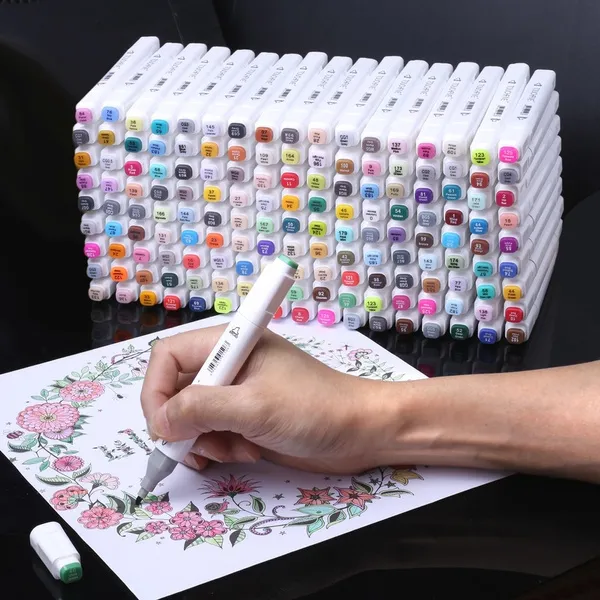
If you plan on purchasing Copics, it is important to know how to utilize them effectively.
In my comprehensive guide on how to effectively utilize alcohol markers, there are more than 11 hours of instructional videos that cover everything from blending techniques and theory to progressively enhancing your abilities with 65 conveniently-sized lessons. Additionally, there are over 50 downloadable resources available for you to access. Lastly, the guide will provide you with detailed instructions on coloring three specific artworks displayed below.
You will receive printable line art, allowing you to work at your own speed. Additionally, you will have access to my personal collection of over 250 Copic blends, a custom Copic color chart, and many other resources.
To Sum Up
In conclusion, as both an artist and an author of coloring books with extensive experience in using various markers, particularly Copic Markers, I can confidently attest to their exceptional quality and versatility. Copic Markers have rightfully earned their reputation as the preferred choice among artists, illustrators, and colorists worldwide.
These markers stand out for their smooth application, vibrant color selection, and the ability to layer and blend without streaking. Their durability, thanks to refillable ink and replaceable nibs, makes them a cost-effective choice for artists in the long run.
Copic offers three main marker types: Classic, Sketch, and Ciao, each with its own set of features and price points. While the choice between them depends on individual preferences and budgets, the Sketch markers, with their wide color range and versatile brush tip, remain a personal favorite and a top recommendation.
Copic’s extensive color range of 358 options allows for endless creativity and blending possibilities, though it’s important to note that the number of colors should not be the sole deciding factor when choosing markers.
Despite concerns about lightfastness, which is common with markers, the creative freedom and ease of use offered by Copic Markers outweigh potential longevity concerns, especially in the digital age where artworks can easily be preserved digitally.
While Copic Markers may seem expensive, they are a worthwhile investment for serious artists. However, for those on a budget, there are alternative markers like Blick Studio Brush Markers, Ohuhu Markers, and Arrtx Markers that offer quality at a lower cost.
Copic Markers are indeed a remarkable tool for artists seeking versatility, quality, and vibrant colors in their work. Whether you’re a professional artist or a hobbyist, Copic Markers can elevate your creative projects and offer a rewarding coloring experience.


